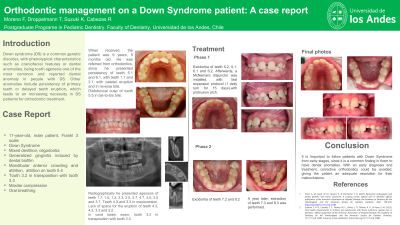Orthodontics
395 - Orthodontic management on a Down Syndrome patient: A case report

.jpg)
Florencia Moreno, DDS
Student
Universidad de Los Andes, Santiago, Chile
Universidad de Los Andes, Chile
Santiago, Region Metropolitana, Chile- RC
Roxana Cabezas, -
Universidad de Los Andes
- DB
Daniela Becerra, -
Universidad de Los Andes
- TD
Trinidad Droppelmann, -
Universidad de Los Andes
- AO
Andrea Ormeño, -
Universidad de Los Andes
- AO
Andrea Ormeño, -
Universidad de Los Andes
Santiago, Region Metropolitana, Chile - RC
Roxana Cabezas, -
Program Director
Universidad de Los Andes
Santiago, Region Metropolitana, Chile
Presenting Author(s)
Co-Author(s)
Research Mentor(s)
Program Director(s)
Down syndrome (DS) is a common genetic disorder, with phenotypical characteristics such as craniofacial features or dental anomalies, being tooth agenesis one of the most common and frequently reported dental anomalies in people with DS. Other anomalies include persistence of primary teeth or delayed teeth eruption, which leads to an increasing necessity in DS patients for orthodontic treatment. The aim of this report was to describe an alternative treatment performed on a DS patient with maloclussions.
An 11-year-old male patient with Down Syndrome, presents agenesis of several teeth and persistence of primary teeth, with a 3 year follow up by pediatric dentistry and orthodontist. The patient presented malocclusions, with crossbite, reverse bite, and position anomalies.
He underwent programmed extractions of teeth 5.2, 5.1, 6.1, 6.2, 7.3 and 8.3, which led to an adequate resolution for his malocclusions, avoiding the immediate need for corrective orthodontics.
This case shows the importance of an early intervention when dental anomalies are presented in children and the positive outcome that it can have on a DS patient.
Identify Supporting Agency and Grant Number:

.jpg)